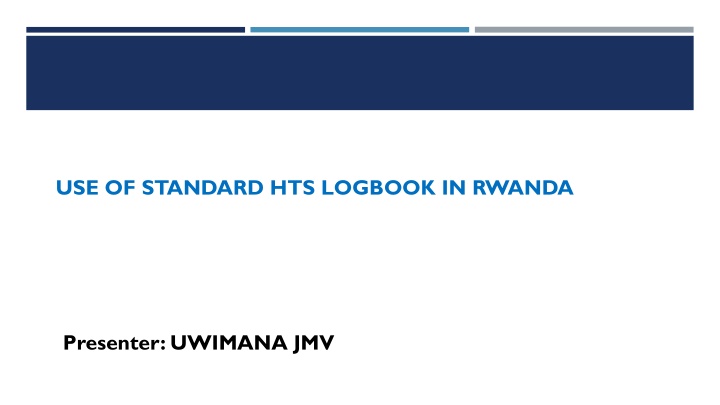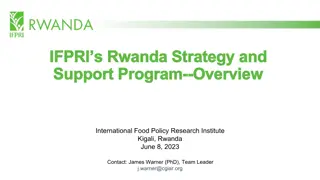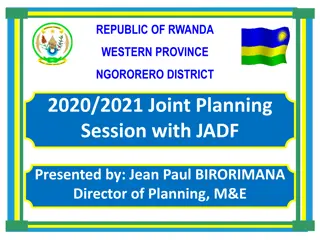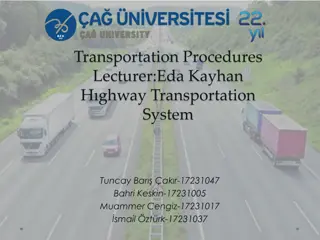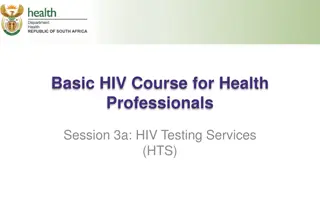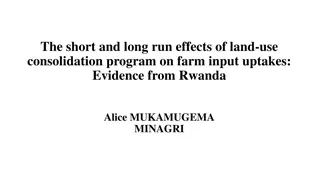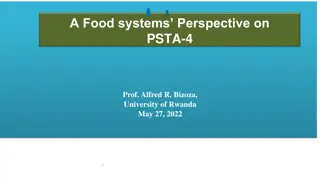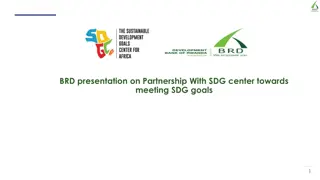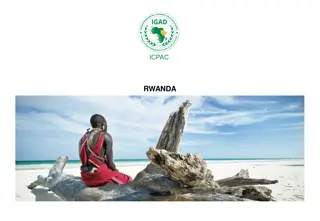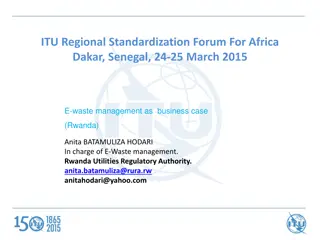Standard HTS Logbook in Rwanda
Develop a deep understanding of the utilization of standard HTS logbooks in Rwanda. Gain insights on how this tool ensures accurate and efficient data recording for healthcare professionals.
Download Presentation

Please find below an Image/Link to download the presentation.
The content on the website is provided AS IS for your information and personal use only. It may not be sold, licensed, or shared on other websites without obtaining consent from the author.If you encounter any issues during the download, it is possible that the publisher has removed the file from their server.
You are allowed to download the files provided on this website for personal or commercial use, subject to the condition that they are used lawfully. All files are the property of their respective owners.
The content on the website is provided AS IS for your information and personal use only. It may not be sold, licensed, or shared on other websites without obtaining consent from the author.
E N D
Presentation Transcript
USE OF STANDARD HTS LOGBOOK IN RWANDA Presenter: UWIMANA JMV
OUTLINE Rwanda and HIV/AIDS situation National Lab network and testing services delivery National HIV Rapid Diagnostic Testing Algorithm Use of HTS standard Logbook in Rwanda Lessons learnt
RWANDA AND HIV/AIDS SITUATION Located in eastern central region of Africa; the land of a thousand hills. Rwanda population is over 13 millions (National Census Report 2022). Female population is higher than male, at 51.5%. Younger population with youth (16-30 yo) constitute 27.1% and 45% children (0-17 yo). HIV/AIDS burden in Rwanda HIV prevalence among adults is 3.0% and low incidence at 0.08% (RPHIA 2018/19). Generalized HIV epidemic with large burden in key populations (UNAIDS). Surpassed (Nationally) the 90-90-90 goals of UNAIDS towards reaching HIV epidemic control by 2030.
NATIONAL LAB NETWORK AND TESTING SERVICES DELIVERY Advanced and specialized routine testing Oversight of the lab network QMS and EQA/PT implementation NRL Level 4 Level 4 Referral Hospital N=8 Complimentary services to routine testing such as microbiology examinations and referred testing lab network Level 3 Level 3 Provincial Hospital N=4 Supports implementation and monitoring for EQA/PT and other quality improvement initiatives at sites in their catchment area such as Q-corps in RTCQI rollout. Level 2 District Hospital N=41 Level 1 Level 1 Public Health Centers N=561 Health Post N=1094 Private Clinics N=318 Routine clinical testing services and implement QA/QC of testing (Biochemistry, Hematology, Microscopy, Rapid device/ Strip tests) Most of the primary healthcare services delivered here including HIV/TB and others
NATIONAL HIV RAPID DIAGNOSTIC TESTING ALGORITHM Early detect Determine Serial algorithm currently with 2 rapid HIV tests Non- reactive Reactive Invalid Handling of inconclusive results Repeat test if invalid Repeat testing after 2 weeks Report HIV- STAT -PAK Refer for PCR test Non- reactive Test outcomes and reported results are recorded into HTS testing register Reactive Invalid Report HIV+ Report Inconclusive
RWANDA EHTS SITUATION Used at 100% PEPFAR sites since 2018 Accessible online Helps monitor the quality of testing across all sites Guides commodity quantification
UTILITY Simplify data aggregation for report generation and review by site supervisor/ manager. Enhances monitoring the quality of testing to inform training needs at testing sites Monthly monitoring of the quality of HIV rapid testing performance at testing points Requires data management procedures and processes for effective reporting Build capacity of the Q-corps to provide adequate quality monitoring skills and offer supportive supervision to HTS sites in their catchment area.
KEY QA INDICATORS FROM LOGBOOK CAPTURED INTO EHTS Client testing code/ID, Age and Sex particulars: Tester particulars Dates of testing and results reported Test kit lot information and kit expiration date Outcome for each test in the algorithm Final HIV test results Page totals
LESSONS LEARNT AND CHALLENGES/OPPORTUNITIES TO IMPROVE Challenges and opportunities Lessons learnt Inadequate data quality including missing data from some sites in eHTS. eHTS facilitates reporting of HTS aggregated data. Helps NRL to: Turnover of trained staffs at site level. Track # of tests performed to inform commodity needs Inadequate support and capacity for Q-corps to perform their responsibility as required. Agreement rates to monitor algorithm/kit performance Requires periodic system upgrade to minimize user error Tester adherence to algorithm to inform training needs Improves commodity forecasting and inventory management. Irregularity in site reporting affects system improvement Additional workload for staff at HF with multiple testing points
ACKNOWLEDGEMENTS US Centers for Disease Control and Prevention (CDC) Africa Field Epidemiology Network (AFENET) Rwanda Biomedical Center/ National Reference Laboratory (NRL) Rwanda Ministry of Health, ICAP and Ngarama Hospital PEPFAR
